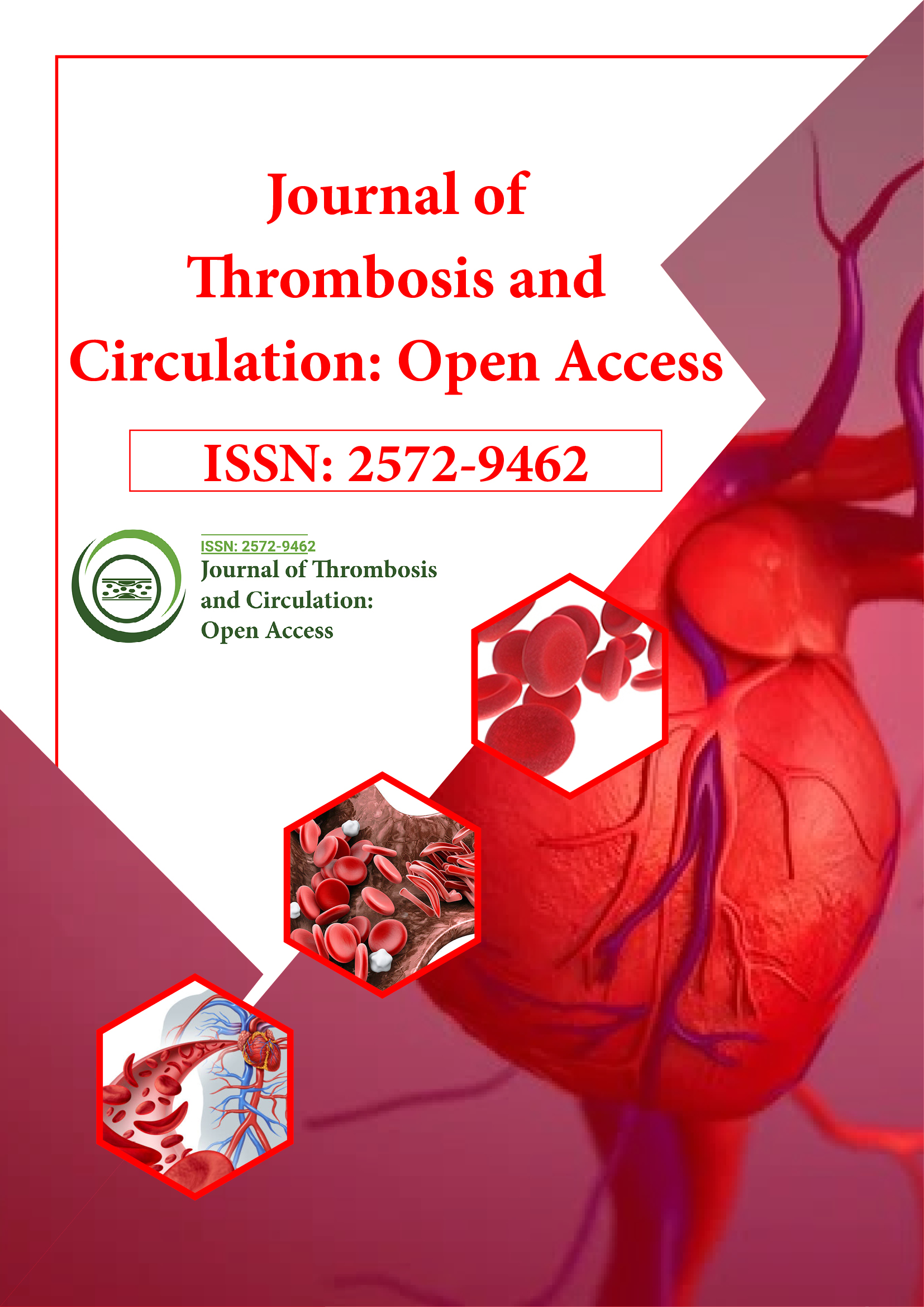Indexed In
- RefSeek
- Hamdard University
- EBSCO A-Z
- Publons
- Google Scholar
Useful Links
Share This Page
Journal Flyer

Open Access Journals
- Agri and Aquaculture
- Biochemistry
- Bioinformatics & Systems Biology
- Business & Management
- Chemistry
- Clinical Sciences
- Engineering
- Food & Nutrition
- General Science
- Genetics & Molecular Biology
- Immunology & Microbiology
- Medical Sciences
- Neuroscience & Psychology
- Nursing & Health Care
- Pharmaceutical Sciences
Commentary Article - (2025) Volume 11, Issue 2
Endothelial Dysfunction and Its Role in Arterial Thrombosis: Pathogenic Mechanisms and Clinical Implications
Thomas Delgado*Received: 30-May-2025, Manuscript No. JTCOA-25-29340 ; Editor assigned: 02-Jun-2025, Pre QC No. JTCOA-25-29340 (PQ); Reviewed: 16-Jun-2025, QC No. JTCOA-25-29340 ; Revised: 23-Jun-2025, Manuscript No. JTCOA-25-29340 (R); Published: 30-Jun-2025, DOI: 10.35248/2572-9462.25.11.305
Abstract
Description
Arterial thrombosis is a leading cause of myocardial infarction, ischemic stroke and peripheral artery disease, contributing significantly to global morbidity and mortality. A crucial but often underappreciated component in the pathogenesis of arterial thrombosis is endothelial dysfunction. The endothelium, once considered a passive barrier, is now recognized as a dynamic regulator of vascular tone, platelet activity, coagulation, inflammation and fibrinolysis. Its dysfunction represents a pivotal event in atherothrombosis, altering the balance between prothrombotic and antithrombotic factors and facilitating clot formation at sites of plaque disruption or vascular injury.
Endothelial dysfunction is characterized by a reduced bioavailability of Nitric Oxide (NO), a potent vasodilator and inhibitor of platelet aggregation and leukocyte adhesion. NO deficiency is typically driven by oxidative stress, often resulting from cardiovascular risk factors such as hypertension, hyperlipidemia, diabetes and smoking. The ensuing imbalance favors vasoconstriction, platelet adhesion and local inflammation — all preconditions for thrombus development. Moreover, dysfunctional endothelial cells upregulate the expression of adhesion molecules (e.g., VCAM-1, ICAM-1), promote leukocyte recruitment and increase tissue factor expression, further tipping the hemostatic balance toward thrombosis.
Atherosclerotic plaques, particularly those rich in lipids and inflammatory cells, are prone to rupture. The exposure of thrombogenic material such as collagen and tissue factor to circulating blood initiates platelet activation and coagulation cascade engagement. In this environment, endothelial dysfunction not only precedes plaque formation but also facilitates the transition from stable to unstable atherosclerotic lesions. The release of Von Willebrand Factor (vWF) by activated endothelial cells enhances platelet tethering and aggregation, while the impaired release of prostacyclin and NO diminishes natural inhibition of thrombosis.
Clinically, endothelial dysfunction is not confined to overt cardiovascular disease. It can be detected in seemingly healthy individuals and serves as an early marker of vascular injury. Noninvasive techniques such as Flow-Mediated Dilation (FMD) of the brachial artery and measurement of circulating biomarkers (e.g., asymmetric dimethylarginine, soluble ICAM-1 and E-selectin) have been used to assess endothelial function. These tools are valuable in risk stratification and monitoring therapeutic response.
Pharmacologic interventions that improve endothelial function have demonstrated beneficial effects on thrombosis risk. Statins, in addition to lipid-lowering effects, enhance NO production and reduce oxidative stress, thereby restoring endothelial homeostasis. Angiotensin-Converting Enzyme (ACE) inhibitors and Angiotensin Receptor Blockers (ARBs) also exhibit endothelial-protective properties, partly by reducing inflammation and vascular stiffness. Antidiabetic agents such as GLP-1 receptor agonists and SGLT2 inhibitors have been shown to exert favorable effects on endothelial function, offering dual cardiovascular and metabolic benefits.
Antiplatelet therapy, particularly aspirin and P2Y12 inhibitors, remains central to the prevention of arterial thrombosis. While these agents act downstream of endothelial dysfunction, their efficacy is indirectly enhanced by upstream measures that restore endothelial integrity. Novel therapies aimed directly at enhancing endothelial function are under investigation, including agents targeting oxidative stress pathways, endothelial progenitor cells and endothelial Nitric Oxide Synthase (eNOS) activators.
Lifestyle modification is a powerful tool in reversing endothelial dysfunction. Regular aerobic exercise improves endothelial NO production, reduces inflammation and enhances vascular responsiveness. Dietary patterns rich in antioxidants, polyphenols, and omega-3 fatty acids contribute to endothelial repair mechanisms. Smoking cessation, weight control and blood pressure regulation further support vascular health and reduce thrombotic risk.
The interplay between endothelial dysfunction and arterial thrombosis is also evident in acute conditions. For instance, in acute coronary syndrome, circulating endothelial cells and microparticles serve as biomarkers of endothelial injury. In stroke, endothelial dysfunction is associated with impaired autoregulation and increased infarct size. Therapeutic interventions targeting the endothelium in these settings could potentially improve acute outcomes and long-term recovery.
In conclusion, endothelial dysfunction is a central mediator of arterial thrombosis and a critical target for preventive and therapeutic strategies. Its role extends from the early stages of atherogenesis to the final thrombotic event, influencing both disease progression and acute clinical outcomes. Recognizing and addressing endothelial health can enhance the effectiveness of antithrombotic therapy and reduce the burden of arterial thrombotic events on a global scale.
Citation: Delgado T (2025). Endothelial Dysfunction and Its Role in Arterial Thrombosis: Pathogenic Mechanisms and Clinical Implications. J Thrombo Cir. 10:305.
Copyright: © 2025 Delgado T. This is an open-access article distributed under the terms of the Creative Commons Attribution License, which permits unrestricted use, distribution, and reproduction in any medium, provided the original author and source are credited.
